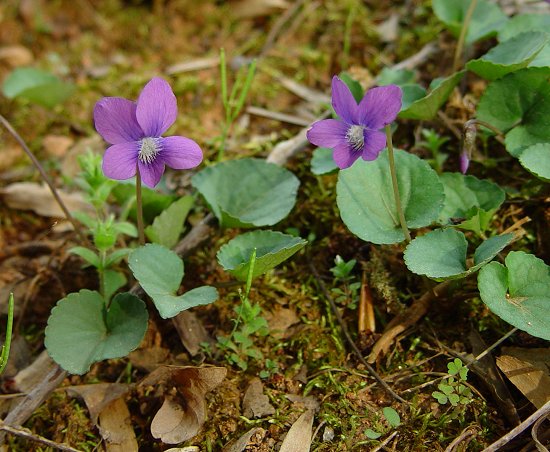Viola papilionacea Pursh
Common Violet

Native
CC = n/a
CW =
MOC = 0
© DETenaglia
Viola papilionacea PurshCommon Violet | |
 |
Native CC = n/a CW = MOC = 0 |
© DETenaglia |
|
Family - Violaceae Stems - A stout, thick, elongated caudex. Leaves - Alternate, arising from ground level. Petioles to 12cm long, glabrous or with some pubescence near base of blade, with single vertical groove running the length of the petiole. Blade to +4cm broad, +3.5cm long, cordate at base, crenate to serrate, glabrous. Lower leaves typically reniform. Upper leaves with a pointed apex, ovate to deltoid.
Inflorescence - Single flowers arising from the base of plant. Peduncles glabrous, to +15cm long, curved at apex, with a pair of small bracts about in the middle of the peduncle. In early spring the flowers much exceed the leaves. Later, the leaves exceed the flowers. Flowers - Corolla variable in color from deep violet to white and nearly all shades between, to 4cm broad and long, zygomorphic. Petals 5. Lateral petals bearded near "throat" of corolla. Lower petal saccate at base, with dark striping and fading to a dull yellow at base. Stamens 5, connate around ovary, two lowest with nectaries. Style deltoid at apex. Sepals 5, 8-9mm long, 3-4mm broad, lanceolate to linear, green with lighter margins, entire, glabrous or with a few hairs at base, rounded at base. auricles 1-2mm long.
Fruit - Capsule to +1cm long, 5-6mm in diameter, slightly 3-angled with angles greatly rounded, glabrous. Seeds numerous. Placentation parietal. Flowering - March - June and sometimes again around October - November. Habitat - Waste ground, fields, meadows, low woods, ditches, roadsides, railroads. Origin - Native to U.S. Other info. - This is a VERY variable plant. The flowers have a wide range of colors and the leaves can be many different shapes and sizes. The flowers can be nearly any color from pure white to deep purple.
The taxonomy of the plant is questionable and some authors place the plant as a variety of V. sororia Willd. Photographs taken in the Mark Twain National Forest, Taney County, MO., 4-10-01, and in Brown Summit, NC., 4-4-03. |